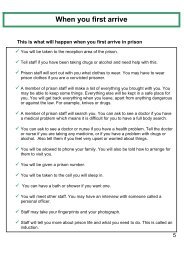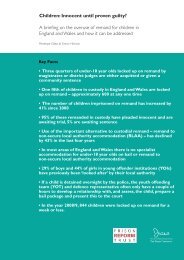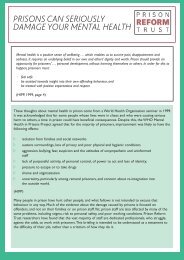BROMLEY BRIEFINGS PRISON FACTFILE - Prison Reform Trust
BROMLEY BRIEFINGS PRISON FACTFILE - Prison Reform Trust
BROMLEY BRIEFINGS PRISON FACTFILE - Prison Reform Trust
Create successful ePaper yourself
Turn your PDF publications into a flip-book with our unique Google optimized e-Paper software.
Mental health needs of prisoners 219“On the wing there was plenty of evidenceof behaviour brought on by mentaldistress… one young man only ever worethe same pair of jeans and a green nyloncagoule. He never wore shoes or socks, neverwent out on exercise, hardly ever spoke toanyone and was understood to have been takenadvantage of sexually by predatory prisoners.He was in his early 20s with many years inprison still ahead of him.Another had a habit ofinserting objects into his body: a pencil in anarm, matchsticks in his ankles.” 220Many prisoners have mental healthproblems. 72% of male and 70% of femalesentenced prisoners suffer from two or moremental health disorders. 20% of prisonershave four of the five major mental healthdisorders. 221Neurotic and personality disorders areparticularly prevalent - 40% of male and63% of female sentenced prisoners have aneurotic disorder, over three times the levelin the general population. 64% of male and50% of female sentenced prisoners have apersonality disorder.According to the NHS plan, around 5,000prisoners at any time, between 5-8%, havesevere and enduring mental illnesses. Theplan also said that, by 2004,“all people withsevere mental illness will be in receipt oftreatment, and no prisoner with serious mentalillness will leave prison without a care plan anda care coordinator.” 222A significant number of prisoners suffer froma psychotic disorder. 7% of male and 14% offemale sentenced prisoners have a psychoticdisorder; 14 and 23 times the level in thegeneral population.10% of men and 30% of women have hadprevious psychiatric admission before theycome into prison. 223A fifth of Scottish prisoners reported thatthey had been put on ACT (Scottish <strong>Prison</strong>Service Suicide Risk Management Process)and 38% of prisoners indicated that theyhad experienced mental health problems. 224A total of 23,420 self-harm incidents wererecorded during 2006 by the <strong>Prison</strong>Service. 225Women accounted for 11,503 or 49% oftotal incidents – even though they form onlyaround 6% of the prison population. 226Latest available data shows that in the threemonths from 1 January – 29 March 2007,there were 2,839 female self-harm incidents(down against 3,200 in the first threemonths of 2006). In the same timescale, therewere 2,904 male self-harm incidents (comparedto 2,636 in the same period in 2006). 227219. All the statistics in this section are taken from Singleton et al (1998) Psychiatric Morbidity among <strong>Prison</strong>ers in England and Wales, London: Office forNational Statistics, unless otherwise stated.220. Erwin James, Foreword to ‘Troubled Inside: Responding to the mental health needs of men in prison’, <strong>Prison</strong> <strong>Reform</strong> <strong>Trust</strong>, 2005221. Paul Goggins, minister for prisons and probation speaking in a debate on prisons and mental health, Hansard, 17 March 2004222. Department of Health, 2000: The NHS Plan: a plan for investment, a plan for reform223. Department of Health, Conference Report, Sharing Good Practice in <strong>Prison</strong> Health, 4/5 June 2007224. Scottish <strong>Prison</strong> Service, 9th <strong>Prison</strong>er Survey 2006225. NOMS, Safer Custody News, May/June 2007226. Ibid.227. Ibid.www.prisonreformtrust.org.uk 27
















